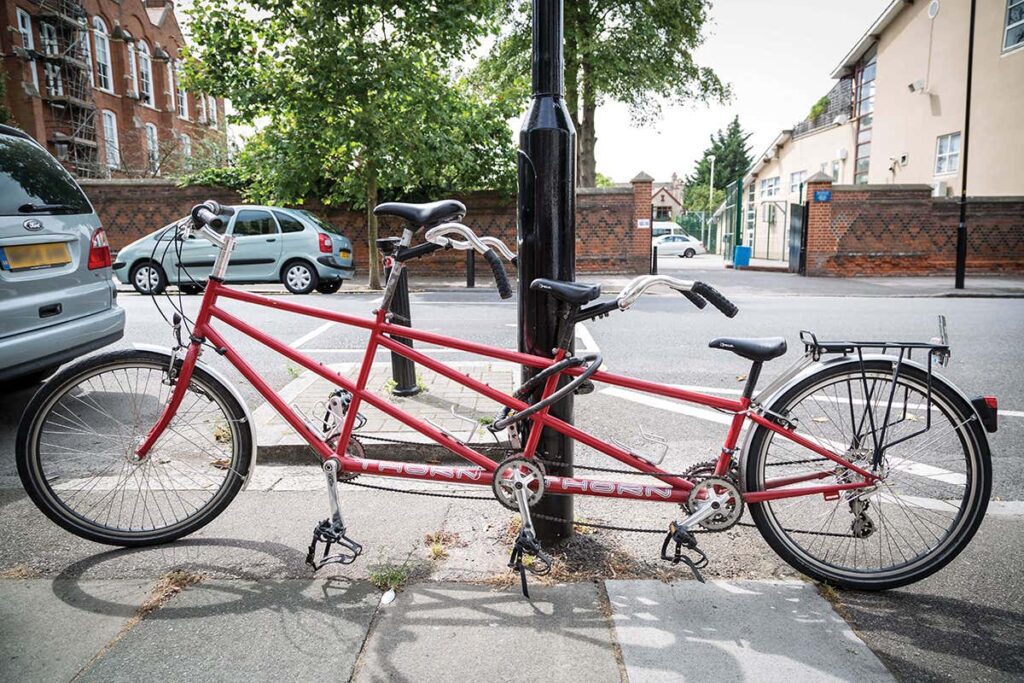Yes, a tandem bike is more efficient than a solo bike due to the ability to share the workload between two riders. This allows for higher speeds and longer distances with less effort compared to riding alone.
Tandem bikes offer an efficient way for riders to share the workload, resulting in higher speeds and longer distances with less effort. The design of tandem bikes allows for synchronized pedaling, making it ideal for efficient travel and reducing individual strain.
The sharing of the workload also leads to improved overall performance and cycling efficiency. This makes tandem bikes a suitable option for cyclists looking to enhance their riding experience with a companion while reaping the benefits of increased efficiency. Moreover, tandem bikes can be a great choice for recreational cyclists and enthusiasts seeking a unique way to enjoy the open road together.
The Mechanics Of A Tandem Bike
Riding a tandem bike can be a whole new experience, offering unique advantages compared to a regular bicycle. Understanding the mechanics behind a tandem bike can help shed light on why it can be a more efficient option for certain situations. In this article, we will explore the frame design and weight distribution of a tandem bike, highlighting the factors that contribute to its efficiency.
Frame Design
The frame design of a tandem bike is a crucial aspect that sets it apart from a regular bike. Instead of the typical single frame, a tandem bike features an elongated frame that accommodates two riders sitting one behind the other. The frame is usually made of lightweight materials like aluminum or carbon fiber to ensure optimal performance and long-lasting durability.
With the riders positioned in a linear manner, the frame of the tandem bike needs to be sturdy enough to handle the increased weight and stress. The elongated frame not only provides stability but also allows for better weight distribution, enabling both riders to contribute to the bike’s forward momentum.
Weight Distribution
A key advantage of riding a tandem bike is the efficient weight distribution. In a regular bike, the weight of the rider is concentrated on a single frame, making it more challenging to maintain balance and control. However, on a tandem bike, the weight is distributed over a longer frame with two riders, resulting in better stability and improved handling.
Moreover, the positioning of the riders on a tandem bike allows for optimized weight distribution. The rider in the front, often referred to as the captain, carries more of the weight since they control the steering and provide the primary driving force. The rear rider, known as the stoker, assists in pedaling and provides additional power to generate speed.
This division of labor between the two riders ensures that the weight is evenly distributed, reducing the strain on each individual and allowing for a more efficient and comfortable riding experience. Additionally, the synchronized pedaling of both riders results in a smoother and more powerful forward motion, further enhancing the bike’s efficiency.
In conclusion, the mechanics of a tandem bike involve a specialized frame design that promotes optimal weight distribution, resulting in improved efficiency compared to a regular bike. The elongated frame and the positioning of the riders allow for better stability, balanced weight distribution, and synchronized pedaling, making a tandem bike a desirable option for riders looking to maximize their cycling experience.
Comparison To Single Bikes
Tandem bikes offer improved efficiency compared to single bikes, allowing riders to share the workload and pedal together for enhanced propulsion and speed. This makes tandems a great choice for those seeking a more efficient biking experience.
Speed And Power
When it comes to speed, a tandem bike has the advantage over a single bike. The combined effort of two riders pedaling together results in a faster pace. The power generated by two pairs of legs working in unison propels the tandem bike forward with greater force. This increased power allows tandems to reach higher speeds compared to single bikes. Moreover, the aerodynamics of a tandem bike are also improved. The streamlined design and the reduced wind resistance make it easier for a tandem to reach and maintain higher speeds, ensuring a thrilling and exhilarating riding experience.
Handling And Control
Handling and control are important factors to consider when comparing a tandem bike to a single bike. While handling a tandem requires coordination and communication between riders, the benefits are worth it. Tandem bikes offer excellent stability due to their longer wheelbase and the weight distribution between two riders. This stability allows for better control when taking turns, especially at higher speeds. Additionally, the presence of two riders makes the tandem more responsive to steering inputs, providing a smoother and more precise riding experience. This enhanced handling and control make tandems a favorite choice among riders seeking a more enjoyable and maneuverable cycling experience.
Efficiency Factors
Tandem bikes are considered more efficient than traditional bikes due to the shared workload and streamlined design. With synchronized pedaling, less energy is wasted, making for a more efficient and enjoyable riding experience. This makes tandem bikes a popular choice for those seeking a more effective biking solution.
Introduction: In exploring the efficiency factors of a tandem bike, it’s crucial to understand how synchronization and drafting benefits contribute to its overall performance.
Synchronization
Synchronization plays a vital role in tandem biking efficiency. Riders must pedal in harmony to maximize power and speed.
Drafting Benefits
Drafting allows the rear rider to reduce wind resistance. This results in improved aerodynamics and energy conservation.
Physical And Mental Benefits
Riding a tandem bike offers a myriad of physical and mental benefits that surpass those of solo cycling. From improved cardiovascular health to strengthened mental resilience, tandem riding presents a host of advantages for both the body and the mind.
Communication And Teamwork
Tandem biking fosters communication and teamwork, requiring synchronized effort from both riders. Each cyclist must communicate effectively to ensure smooth navigation and synchronized pedaling, which can significantly improve communication skills and teamwork abilities.
Motivation And Accountability
By sharing the workload with a partner, riders find motivation and accountability. The mutual support and encouragement between partners can boost motivation levels and hold each other accountable, ultimately enhancing the biking experience.
Challenges Of Tandem Biking
Riding a tandem bike offers a unique set of challenges that riders must navigate. While tandem biking can be an efficient and enjoyable way to travel, it also presents some coordination and maneuvering obstacles that require communication and teamwork to overcome.
Coordination Issues
Tandem biking requires a high level of coordination between both riders. Pedaling in sync and maintaining a steady pace can be challenging, especially for riders with different strengths and abilities. Communication is key to ensure that both riders are working together effectively to maximize efficiency and minimize wasted effort.
Turning And Maneuvering
Navigating turns and maneuvering a tandem bike can be more challenging than riding a single bike. Coordinating when to start a turn, leaning into the turn together, and communicating about obstacles or changes in direction are essential to safely and smoothly navigate varying terrain.


Credit: www.youtube.com
Real-life Applications
Touring And Long-distance Rides
A tandem bike shines in touring and long-distance rides. It allows two riders to work together, maximizing their efficiency. With a tandem, riders can cover more ground with less effort, making it ideal for exploring new places and enjoying scenic routes. The collaborative effort on a tandem not only boosts efficiency but also strengthens bonds between riders.
Athletic Competitions
Athletic competitions also benefit from tandems. In races, tandems offer a competitive edge with two riders powering the bike, enabling faster speeds than solo bikes. Teamwork is crucial in pursuits such as time trials where synchronization is key. Tandem bikes are highly efficient in racing scenarios, providing a unique advantage over traditional bikes.
Environmental Impact
Concerning environmental impact, a tandem bike may outperform single bikes in terms of efficiency due to shared energy and reduced emissions. Riding environmentally friendly tandem bikes can significantly lessen carbon footprint and promote eco-friendly transportation choices.
Carbon Footprint
When it comes to the environmental impact, a tandem bike offers a clear advantage with its reduced carbon footprint. Riding a tandem bike is more energy-efficient compared to two separate bikes. Since both riders share the workload, less energy is expended overall, resulting in lower carbon emissions. This reduced carbon footprint is an important consideration for those who are environmentally conscious and want to reduce their impact on the planet.
Sustainable Transportation
Tandem bikes contribute to sustainable transportation by promoting car-free commuting and reducing traffic congestion. By choosing a tandem bike over a car for short-distance trips or commuting to work, individuals can reduce their reliance on fossil fuels and minimize air pollution. Sustainable transportation options like tandem bikes also have the potential to alleviate some of the environmental and health issues associated with expensive car maintenance and high levels of carbon emissions. In addition to being environmentally friendly, tandem bikes provide other benefits such as improved social interaction, teamwork, and a unique bonding experience for the riders.
Moreover, tandem bikes are known for their versatility, making them suitable for various activities like leisurely rides, touring, or even participating in tandem bike races. With concerns about climate change and air pollution growing each day, making sustainable choices like using a tandem bike can make a significant difference. By opting for this eco-friendly mode of transportation, individuals can actively contribute to reducing their carbon footprint and promoting a healthier planet for future generations. So, why not consider hopping on a tandem bike and enjoy the many benefits it has to offer?


Credit: www.cyclinguk.org
Frequently Asked Questions Of Is A Tandem Bike More Efficient
Are Tandem Bicycles More Efficient?
Tandem bicycles can be more efficient because two riders working together can generate more power. They allow for better aerodynamics and are ideal for long-distance rides. However, it depends on the riders’ abilities to work in sync and communicate effectively.
What Are The Disadvantages Of Tandem Bikes?
Tandem bikes have a few drawbacks. They can be challenging to maneuver and steer, and they require good communication between riders. It can be difficult to find a suitable riding partner as well. Additionally, tandem bikes tend to be heavier and more expensive compared to regular bikes.
How Fast Can You Go On A Tandem Bike?
On a tandem bike, you can reach speeds of up to 30 miles per hour, depending on the riders’ abilities and the terrain.
Do Both People Pedal On A Tandem Bike?
Yes, both people pedal on a tandem bike, working together to propel the bike forward.
Conclusion
In essence, a tandem bike offers a blend of efficiency and camaraderie for riders. It enables shared efforts and promotes teamwork while riding smoothly. The benefits of a tandem bike extend beyond just physical efficiency, fostering communication and connection among riders.
So, consider trying out a tandem bike for a unique cycling experience!



